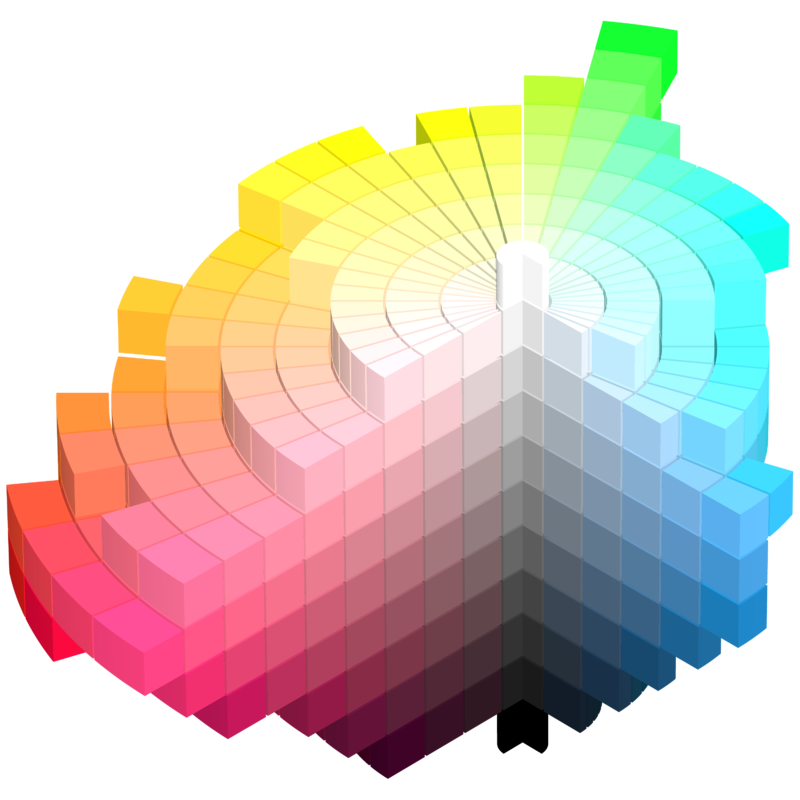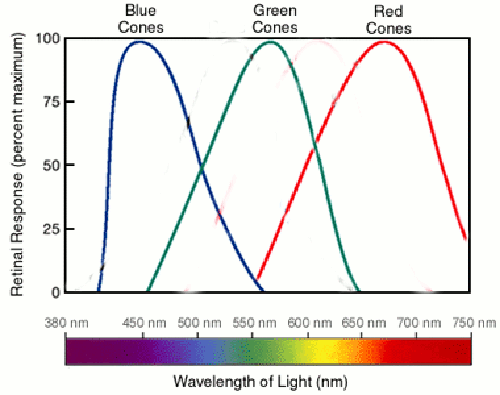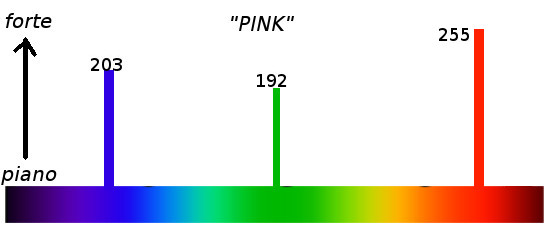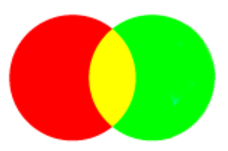Rainbow, Part II: Yellow Is An Idea

This is part II of my discussion of color which began with Part I, “The Infinite Piano”. In the first part I explained that the colors of the rainbow are single “notes” on an infinite piano whose keys are pure “tones” of light, and the “sheet music” for a more complex color such as PINK can be written as a 3-note chord composition in RED, GREEN, and BLUE. This composition can be written out over the color piano keyboard with three vertical bars, each indicating the loudness or softness of each of the three keys we need to play, using ranges from 0 to 255, like this:
We can further shorten this musical notation by saying (Red,Green,Blue) = (255, 192, 203). Now you may think that I just made up those particular numbers, but in fact if you check with Wikipedia, the internet standard for color on computer displays has exactly these three values for the color pink. They chose the range 0 to 255 because it is easy to express using 8 bits — which makes computers happy.
We live in the computer age, and this (R,G,B) system is now used to define all the colors that you can see on a computer monitor. So, it sounds like color is three dimensional, and you can represent any color in nature (or at least in a photo of nature) using just three colors. But is this true ?
Anyone who has tried to match paint colors may doubt this. Each paint manufacturer has their own system of specifying colors, and complex formulas of mixing their “component” pigments into Salmon, Chestnut, or other copyrighted name and color. There are many systems of defining color, such as Munsell and CIE-Lab, which are 3-dimensional, like this:

3D Munsell color space (Wikipedia – credit)
These systems are oriented toward luminance-based applications such as TV’s and computer monitors that emit their own light. There are also CMYK (Cyan-Magenta-Yellow-BlackKey) and Pantone™ systems, which are effectively 4 dimensional dimensional and used mostly in pigment-based applications such as printing and paint. But Pantone also had a six-dimensional version called Hexachrome, which add Orange and Green to form a CMYKOG space (now discontinued), and there is also a CcMmYK system used in six-color inkjet printers. These latter are called “subtractive” systems, because the pigments effectively absorb colors from white light to give you their indicated color.
So clearly something must be going on. Why do we even think color is three dimensional, when there are so many color systems using more than three. What’s up?
The Yellow That Isn’t There
Let’s take a closer look at this Wikipedia computer color thing. If you look up Yellow in wikipedia, you’ll see that standard Yellow is defined in color coordinates by (R,G,B) = (255, 255, 0). But if we plot that “musical chord” out on our piano we get this:
Now this is crazy, because there is clearly a “yellow” key halfway between green and red, and we aren’t hitting that key at all. Instead we are leaning with a strong 255 “forte” on both RED and GREEN. Indeed, in the same Wikipedia entry for Yellow, it indicates that the “spectral” coordinates of Yellow is 570–590 nanometers. This is the wavelength of the light which is colored yellow in the rainbow spectrum.
To understand what is going on requires an understanding of human beings more than the color spectrum, and how we evolved. Modern humans perceive color with the use of three kinds of cells in the retina of our eyes, called cones. These cones come in three types, each of which respond only to specific “chords” in the color spectrum. The three chords look something like this (approximately):
 What this says is that we have in our eyes three kinds of cells (not counting rods which detect brightness), which respond to “color chords” that are centered (roughly) around the blue, green and red keys. There is no cell that responds just to “yellow” chords, and so the way that we “see” the yellow color is that our brains get strong positive signals from both the Green and the Red cones.
What this says is that we have in our eyes three kinds of cells (not counting rods which detect brightness), which respond to “color chords” that are centered (roughly) around the blue, green and red keys. There is no cell that responds just to “yellow” chords, and so the way that we “see” the yellow color is that our brains get strong positive signals from both the Green and the Red cones.
One of the interesting consequences is that it is possible to make a person “see” yellow even if there is no yellow in the light at all. All you have to do is to take a pure green and red light (such as from two distinct lasers), and shine them on the same spot on the wall:
Our retinas will report to the brain that where they intersect it is getting a strong green and red signal, and the brain will interpret that as yellow — even though a light spectrometer pointed at the wall will report that there is no yellow there at all. It is a color optical illusion !
Here is the take-away from all this: the color YELLOW is an IDEA, as are all other colors. It is something unique that our brain thinks — a state of mind — in response to what the outside world is doing. In the case above, the YELLOW our brain “sees” is entirely in our own heads. Now most of the time, in nature, there really is a yellow frequency light wave “out there”, and we know from the yellow in the rainbow that this frequency of light actually exists. You can create a pure yellow by simply dropping salt into a flame (sodium ions radiate at that color). But the idea of yellow must be distinguished from the light that usually triggers it.
And so, YELLOW as a specific color of light must be understood as a separate dimension from RED, GREEN, and BLUE. So how many dimensions does color really have? We will explore this further in the next post, “Shadows of The Infinite.”



